14 photos that received high marks at the Wildlife Photographer of the Year 2024 competition (15 photos)
The Wildlife Photographer of the Year competition has unveiled some of this year’s outstanding, highly commended entries ahead of the winners being announced in October. From a jaguar hunting a caiman to a close-up of David Bowie’s spider, these images illustrate the wonders of nature. 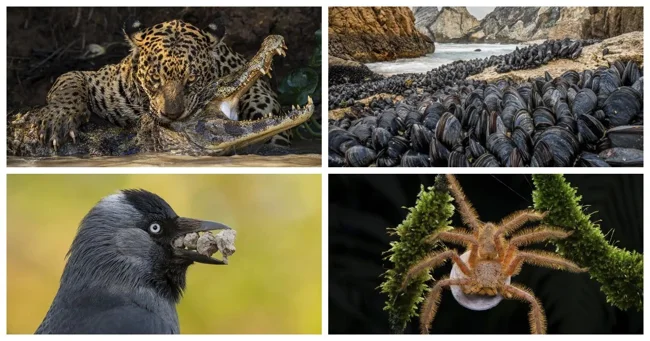
The 60th edition of the competition, organised by London’s Natural History Museum, attracted a record 59,228 entries from photographers of all ages and skill levels from 117 countries and territories. An international jury of photography experts judged the entries on creativity, originality and technical excellence. These images are just a few of the 100 that will be on display in the upcoming Wildlife Photographer of the Year exhibition, including Randy Robbins’s stunning photograph of a frozen fallow deer, the first smartphone image to win the award. Themes of life and death are present in many of the entries, including William Fortescue’s black and white image of mating lions and Tommy Trenchard’s image of a shark struggling as it is hauled aboard a Spanish fishing boat.
“This collection showcases the diversity of species, behaviours and conservation issues,” says Katie Moran, chair of the competition’s jury. “These images reflect the evolution of the competition over the years, from pure natural history to images that fully capture the beauty and challenges of the natural world. This is a powerful collection with which to begin our anniversary celebrations.”
1. "The Killing Bite" © Ian Ford, Highly Commended, Behavior: Mammals 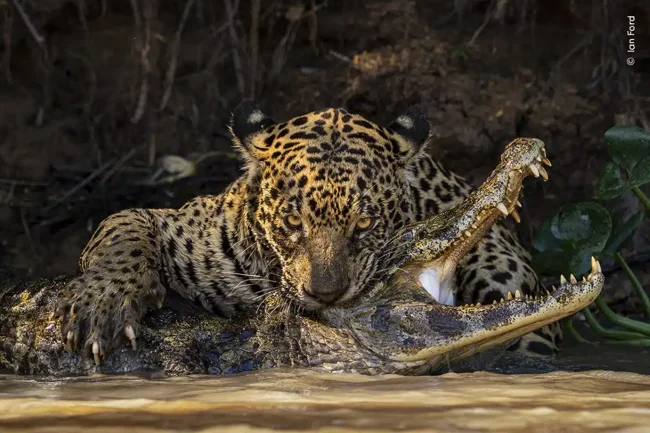
Ian Ford captured the moment a jaguar delivered a fatal bite to a caiman in the Pantanal. Ian radioed in that a jaguar had been spotted on the banks of a tributary of the Sao Lourenço River. Kneeling in his boat, the photographer was in the perfect position to capture the moment the cat delivered a devastating bite to the skull of an unsuspecting yacare caiman. The Pantanal wetlands of South America are home to the highest density of jaguars in the world. With such an abundance of prey, jaguars do not have to compete for food, and the usually solitary big cats are seen fishing, traveling, and playing together.
Shooting location: Pantanal, Mato Grosso, Brazil
Technical details: Sony α1 + 400mm f2.8 lens; 1/800 at f4 (-1 e/v); ISO 400
2. "Ziggy Spider" © Lam Soon Tak, Highly Commended, Behavior: Invertebrates 
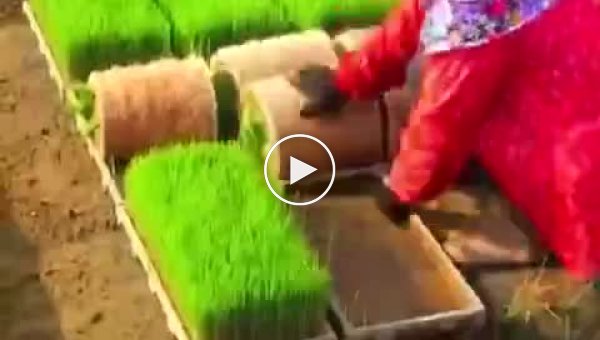
Lam Soon Tak spotted a brightly colored David Bowie spider carrying an egg sac. Lam was exploring the highlands of Malaysia when he came across this spider. The spider was perched on broken branches near a river, the bright white disc of eggs in the spider's jaws and its orange body standing out against the lush green moss. Found in Malaysia, Singapore and the Indonesian island of Sumatra, the species was named in 2008 by arachnologist and Bowie fan Dr Peter Yeager, who decided that the spider's striking markings on its head were reminiscent of the makeup the singer wore in the 1970s.
Shot location: Cameron Highlands, Pahang, Malaysia
Technical details: Nikon Z 8 + 105mm f2.8 lens; 1/125 at f20; ISO 250; multiple flashes + homemade diffusers
3. "Stormy Scene" © William Fortescue, Highly Commended, Behavior: Mammals
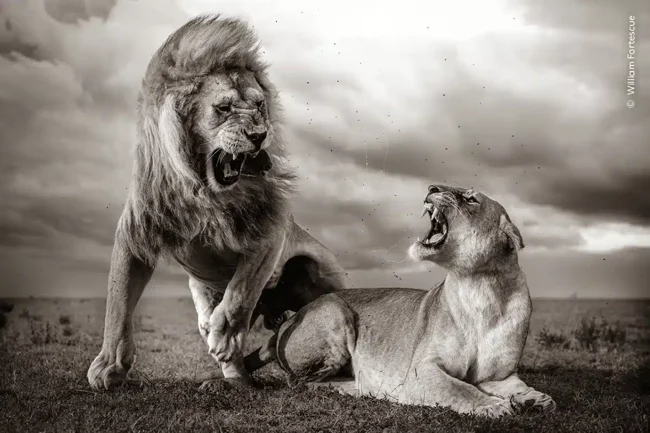
William Fortescue uses a backdrop of storm clouds illuminated by the setting sun to show lions mating. It was the rainy season when William visited Serengeti National Park. He watched the lions mate several times until the female interrupted the mating. It was only when William zoomed in on the image that he noticed traces of saliva and an "explosion" of insects from the male's mane. Lions can mate throughout the year, but having cubs born in sync increases the pride's reproductive success. Pride females exhibit cooperative behavior, including cooperative raising of young, to ensure their survival as adults.
Shoot Location: Namiri Plains, Serengeti National Park, Tanzania
Technical Details: Nikon Z 9 + 70-200mm f2.8 lens; 1/1000 at f5; ISO 320
4. Hooked © Tommy Trenchard, Highly Commended, Oceans: The Big Picture
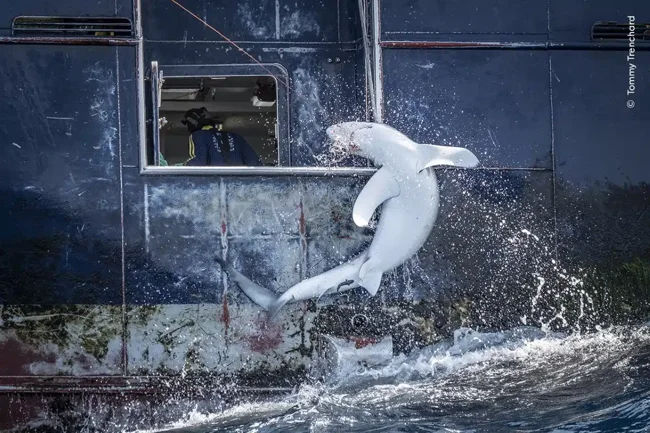
Tommy Trenchard documents the bycatch of a grey sawtooth shark, its body arched in a last-ditch effort to resist. Tommy was on board the Greenpeace vessel Arctic Sunrise. The aim of the research expedition was to document shark bycatch by tuna and swordfish fishing vessels and highlight the lack of effective regulation of industrial fishing in international waters. Around 80 million sharks are caught in the world’s oceans every year. Due to fishing, shark numbers have declined significantly worldwide since 1970. Three-quarters of all shark species are now threatened with extinction.
Shooting location: International waters, South Atlantic Ocean
Technical details: Fujifilm X-T2 + 50-230mm f4.5-6.7 lens; 1/550 at f5.2; ISO 500
5. "The Last Resort" © Randy Robbins, Highly Commended, Natural Artistry

Randy Robbins is struck by the unusual beauty of this doe's frozen form on the forest floor. Early one winter morning, Randy was checking security cameras near his home when he discovered the frozen body of a doe. He captured this extraordinary shot on his smartphone before the frost melted.
Shooting Location: Susanville, California, USA
Technical Details: Apple iPhone XR; 4.25mm built-in lens; 1/121 @ f1.8
6. “Turning Leap” © José Manuel Grandio, Highly Commended, Behavior: Mammals

José Manuel Grandio braved the cold to see a stoat leap high into the air above the snow. Winter is José’s favorite season for photography. When he spotted this stoat leaping through the air, he described the display as “an expression of delight” as the little mammal literally tumbled through the freshly fallen snow. Scientists call this behavior dancing, although opinions differ on what motivates it, from an attempt to confuse prey to a parasitic infection. Stoats are usually active at night and hunt small mammals and birds.
Shot location: Atoz, Bourgogne-Franche-Comté, France
Technical details: Nikon D500 + 500mm f4 lens; 1/6000 at f4; ISO 800
7. Moonlight Hunter © Xinchao Zhu, Highly Commended, Behavior: Mammals
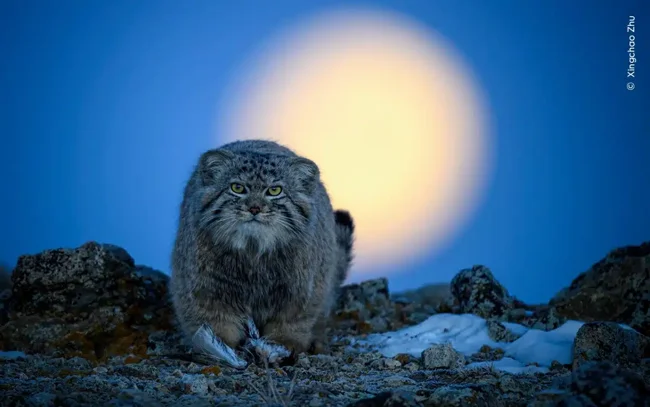
Xinchao Zhu comes face to face with a Pallas's cat as the moon sets. In February 2023, during the Chinese New Year, Xinchao spent several days tracking a group of Pallas's cats on the freezing plateau of Inner Mongolia. Just before dawn, Xinchao managed to make eye contact with the cat, just as it was catching a small bird. Pallas's cats' thick winter fur helps them survive at altitudes of up to 5,000 meters. They avoid larger predators by being stealthy, and their low, rounded ears are thought to allow them to peer around obstacles without being seen.
Shoot location: Hulunbuir, Inner Mongolia, China
Technical details: Nikon Z 9 + 800mm f6.3 lens; 1/160th at f6.3; ISO 1400
8. Spotlight © Shrayovi Mehta, Runner-up, 10 years and under

Shrayovi Mehta has discovered two Indian birds that are “perfect for photography.” Shreyavi was walking in the forest with her parents when she spotted the scene. She ran up to her father, who was carrying a camera, and then dropped to the ground to take a low-angle shot. Keoladeo is famous for its birdlife, with a large number of waterfowl visiting in winter. Peacocks are year-round residents, nesting in large trees. They rest in the shade during the day, and are more active in open areas at dawn and dusk.
Shooting location: Keoladeo National Park, Rajasthan, India
Technical details: Canon EOS R5 + 100-500mm f4.5-7.1 lens; 1/800 at f10; ISO 1600
9. "Vanishing Ice Cap" © Thomas Vijayan, Highly Commended, Oceans: The Big Picture
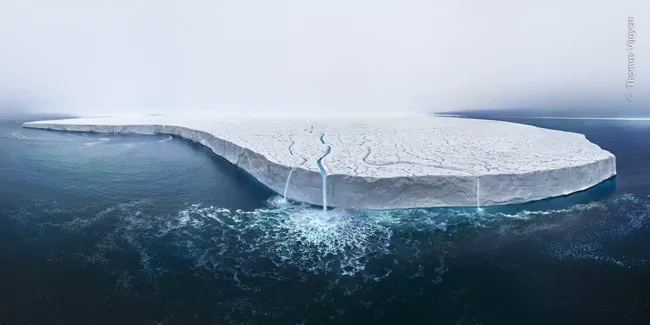
Thomas Vijayan uses his drone to show the epic scale of the Brosvellbreen Glacier. It took careful planning and favorable weather conditions to capture the full splendor of the Austfonna Ice Cap. Thomas’s image, a stitched panorama of 26 individual frames, offers a stunning summer view of meltwater cascading over the edge of the Brosvellbreen Glacier. The Brosvellbreen Glacier is part of the Austfonna Ice Cap, Europe’s third-largest. The ice cap is one of several that cover the landmass of the Svalbard archipelago. Some scientific models suggest that the Svalbard glaciers could disappear entirely within 400 years due to climate change.
Shooting Location: Svalbard, Norway
Technical Details: DJI Mavic Mini 2 + 24mm f2.8 lens; 26 individual exposures
10. “Strength in Numbers” © Theo Bosboom, Highly Commended, Animals in Their Habitat
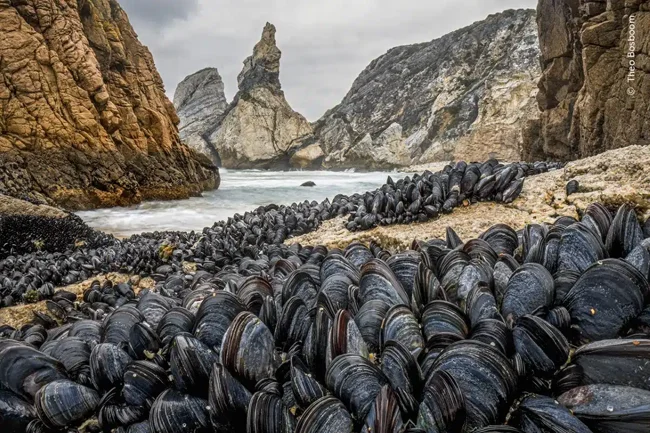
Theo Bosboom shows how mussels bind together to prevent them from being washed away from the shoreline. Theo likes to photograph species that are not usually considered beautiful or important to highlight their undervalued importance. He took this image from above using a probe lens – a long, thin, macro wide-angle lens. Mussels play an important role in creating dynamic ecosystems for other marine invertebrates such as crustaceans, worms and even small fish. They improve the quality of water by filtering it, removing plankton, as well as bacteria and toxins, preventing them from accumulating to dangerous levels.
Shooting location: Praia da Ursa, Sintra, Portugal
Technical details: Canon EOS R5 + Laowa 24mm Periprobe lens; 0.6 seconds at f32; ISO 200; 9 image focusing stack
11. Moving With the Ice © Tamara Stubbs and Atlantic Productions, Highly Commended, Animals in Their Habitat

Tamara Stubbs spotted crabeater seals napping among the sea ice. During a nine-week expedition in the Weddell Sea, Tamara noticed the seals asleep next to the ship, with the tips of their nostrils near the surface of the water. These two raised their heads to take a deeper breath. There are about four million crabeater seals in Antarctica. Although they are not considered endangered or threatened, the seals are protected by international conservation agreements. More research is needed to understand how climate change and tourism will affect their populations.
Shooting location: Weddell Sea, Antarctica
Technical details: Sony α7R II + Canon 24-70mm f2.8 lens at 70mm; 1/320 at f7.1; ISO 100; polarizing filter
12. "Gems" © Samuel Stone, Highly Commended, Behavior: Birds
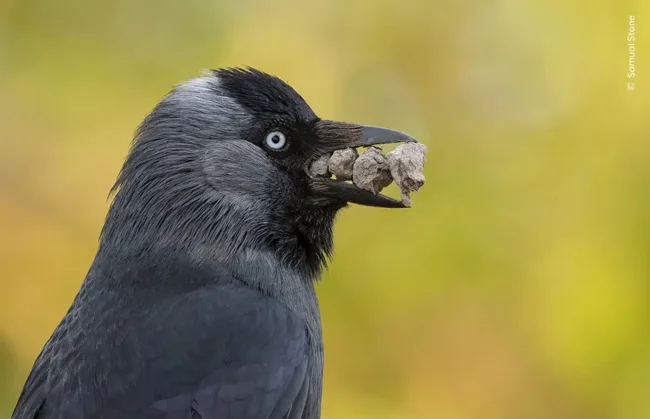
Samuel Stone was watching a hole in a half-rotted willow tree in London's Bushy Park - he saw a pair of jackdaws visiting with their beaks full of hair taken from local deer. Jackdaws are very intelligent and adaptable. Each year they build new nests from a variety of materials: twigs, branches, feathers, wool, moss, mud, and animal excrement. This pair was constantly adding stones to their nest.
Shooting location: Bushy Park, London, England, UK
Technical details: Nikon D5500 + Sigma 150-600mm f5-6.3 lens; 1/500 at f6.3; ISO 800
13. Leaving the Nest © Sasha Dzhumanka, Highly Commended, 10 years and under
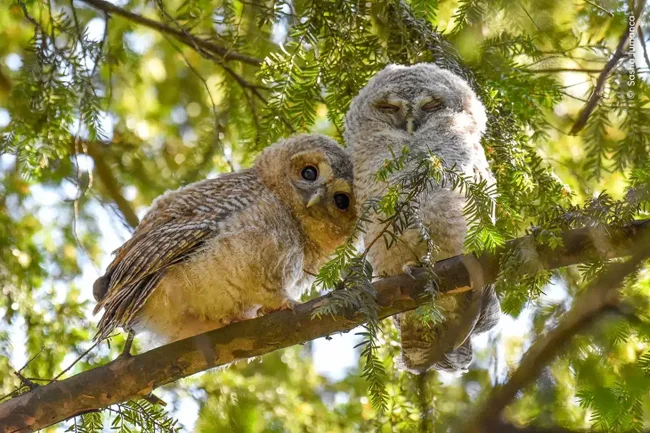
Sasha Dzhumanka discovered two baby owls curiously watching people pass by. Sasha had been observing these owls for several days in the park near his home. He had seen owls in the area before, but was surprised to find them so close to the city centre. The owlets leave the nest before they can fly, in a stage known as ‘branching’. For several weeks they will hop, flutter and climb the branches of nearby trees, begging their parents for food, before eventually fledgeling and flying away.
Photo location: Maximiliansanlagen, Munich, Germany
Technical details: Nikon D7200 + 200-500mm f5.6 lens at 270mm; 1/500 at f6.3; ISO 2200
14. "Spotlight" © Georgina Steitler, Highly Commended, Behavior: Invertebrates
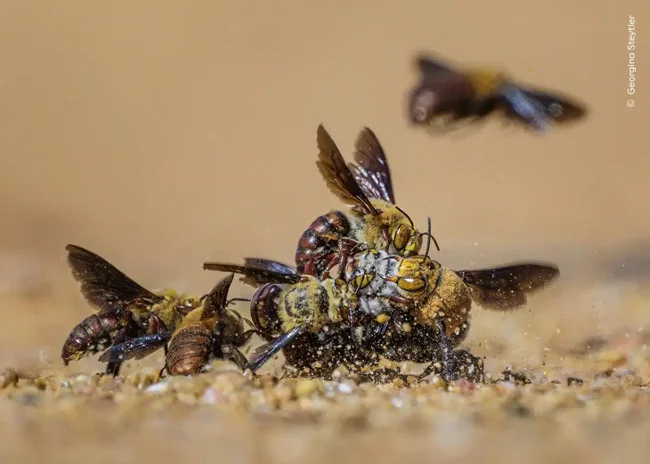
Watching a clump of male Dawson's bees vying for access to a female. Georgina has been studying these bees for a few years now and knew she had to keep her distance. Lying on the hot, rocky, sun-baked ground with sand blowing into her face, her long lens gave her the perfect shot. When female Dawson's bees emerge in the spring, they are surrounded by males competing to mate with them. After mating, the female digs a new burrow filled with pollen and eggs, from which the bees hatch in the spring.
Shooting location: Carnarvon area, Western Australia, Australia
Technical details: Nikon Z 8 + 800mm f6.3 lens + 1.4x teleconverter; 1/5000 at f11; ISO 640

